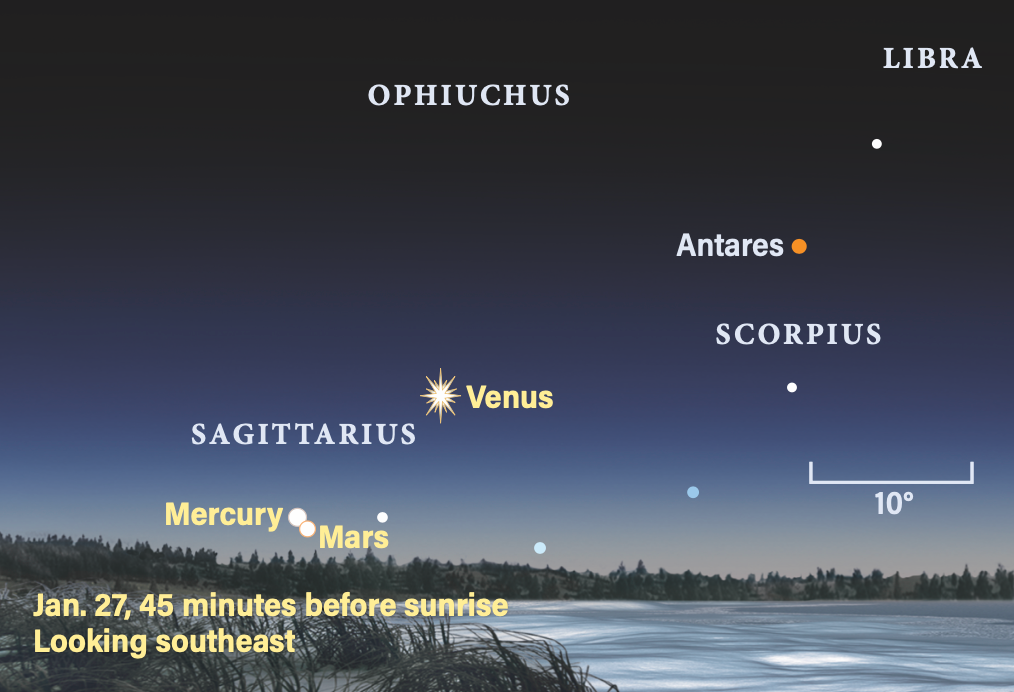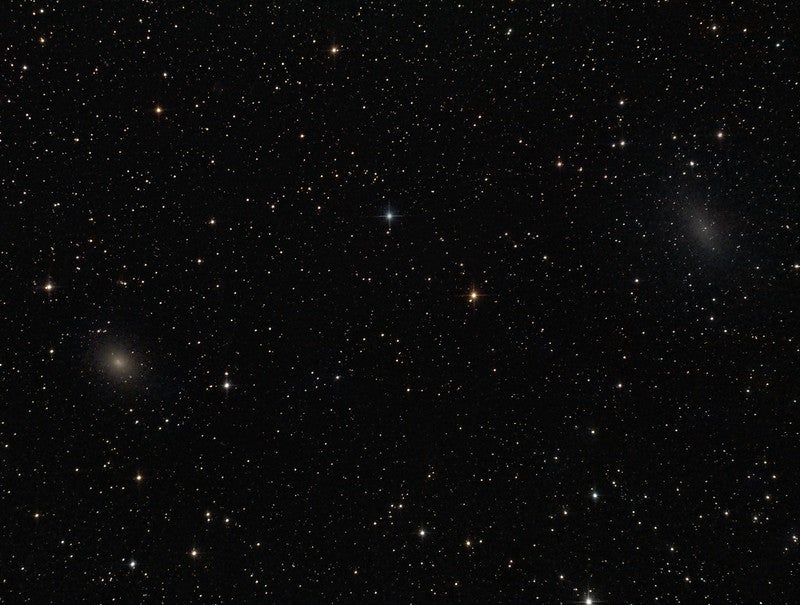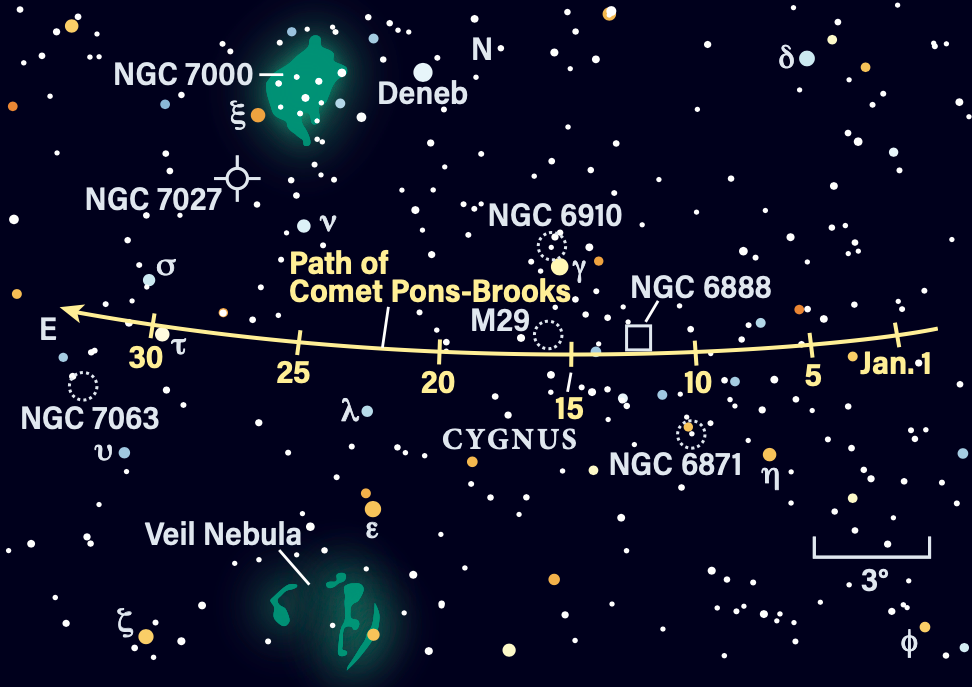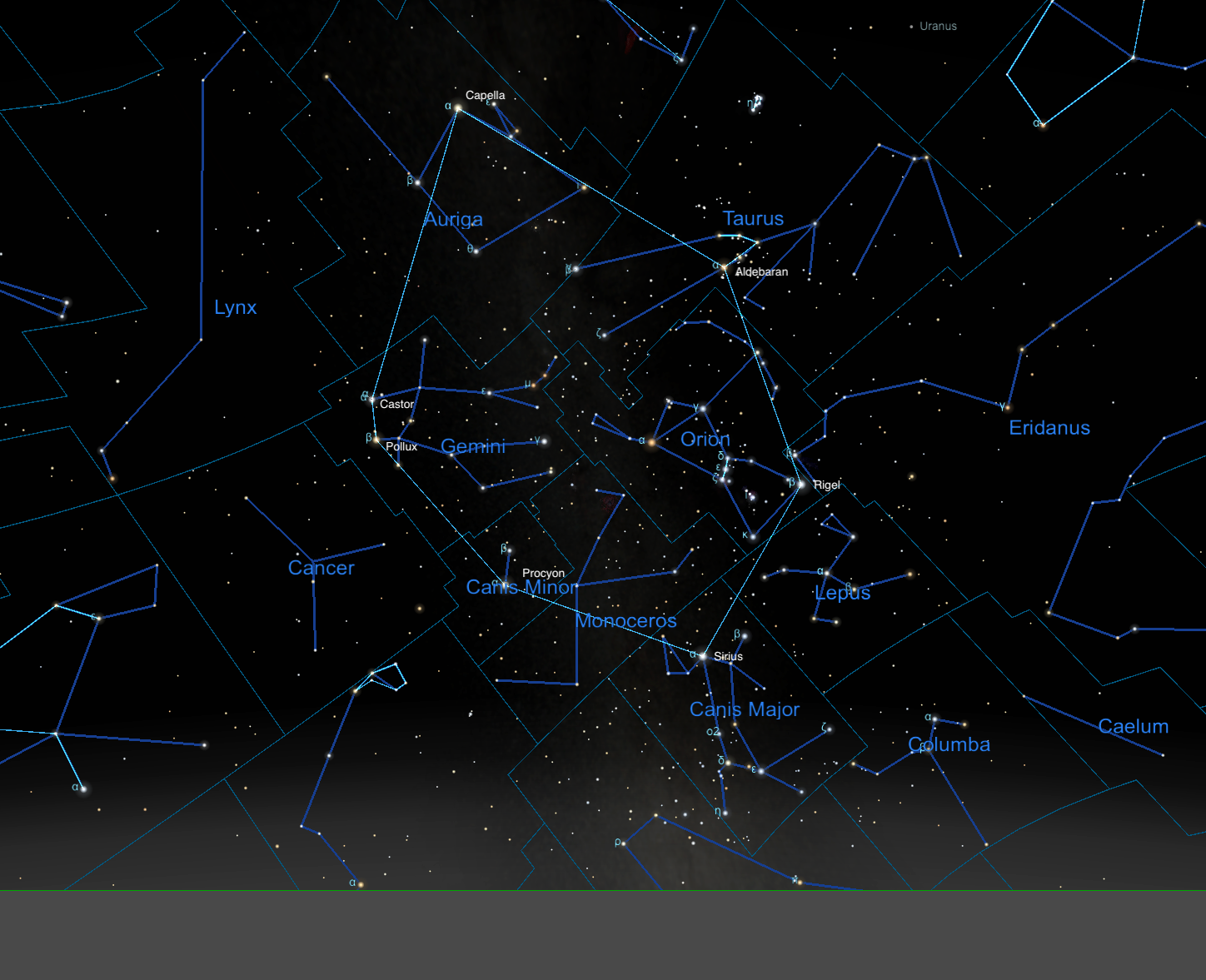
Friday, January 26
A bright Moon is rising roughly an hour after the Sun disappears, but that’s still enough time to catch a glimpse of the solar system’s most distant planet. The ice giant Neptune stands some 30° high in the southwest an hour after sunset. At magnitude 7.8, it requires binoculars or a telescope to spot. You’ll find it in southwestern Pisces, near the Circlet asterism in that region of the constellation. Locate magnitude 4.5 Lambda (λ) Piscium, then drop about 4.8° south — there’s your target.
Neptune’s disk appears nearly pointlike, just 2″ across. That’s because of its distance, now some 30.5 astronomical units from Earth. One astronomical unit, or AU, is the average Earth-Sun distance of 93 million miles (150 million kilometers). Neptune is 30 times that distance from us!
Continue heading in roughly the same direction away from Lambda and eventually you’ll reach Diphda, Cetus’ 2nd-magnitude beta star. This sun is the brightest star in Cetus (despite its beta label) and is also known as Deneb Kaitos. It shines some 145 times as bright as the Sun and is a dying giant star about three times as massive as the Sun. When it finally fades, it won’t go out with the bang of a supernova, but with the gauzy, ethereal bubble of a planetary nebula.
Sunrise: 7:15 A.M.
Sunset: 5:12 P.M.
Moonrise: 6:09 P.M.
Moonset: 8:08 A.M.
Moon Phase: Waning gibbous (99%)
*Times for sunrise, sunset, moonrise, and moonset are given in local time from 40° N 90° W. The Moon’s illumination is given at 12 P.M. local time from the same location.
Saturday, January 27
Uranus is stationary against the background stars of Aries at 6 A.M. EST. It’s visible in the evening sky but we’ll come back to it tomorrow, as today there’s a much more important event to catch: A conjunction of Mercury and Mars in the predawn sky.
Mercury officially passes 0.2° north of Mars at 11 A.M. EST. The two sit low in the southeast early this morning, some 2° high about 45 minutes before sunrise. They are roughly 15′ apart. You can use bright Venus as a guide — the magnitude –4 planet lies 10° above the horizon that time and is an easy-to-spot morning star. Once you’ve found it, look about 12° east (toward the lower left) of Venus to land on the Mercury-Mars pairing, close to the horizon. An observing site with a slightly higher altitude than its surroundings and a southeastern horizon clear of trees or buildings will be best.
Mercury (the brighter of the two at magnitude –0.3) lies just to Mars’ (a much fainter magnitude 1.3) upper left. They’ll easily fit into the same field of view of any binoculars or telescope. Mercury shows off a gibbous disk some 84 percent lit and 5″ wide. Mars appears full, but it also looks slightly smaller due to its greater distance from Earth: just 4″ wide.
Come back tomorrow at the same time for another look — by then, Mercury will have moved to Mars’ lower left. The two will then stand about 40′ apart.
Sunrise: 7:13 A.M.
Sunset: 5:13 P.M.
Moonrise: 7:11 P.M.
Moonset: 8:34 A.M.
Moon Phase: Waning gibbous (96%)
Sunday, January 28
Tonight let’s check in with Uranus in the constellation Aries, which it shares with the mighty planet Jupiter.
The latter planet stands out as the brightest point of light high in the south an hour after sunset. Let’s start with it first: Jupiter shines at magnitude –2.4 and is a treat to view through a telescope. Its disk stretches 40″ across and is flanked by its four largest moons, Io, Europa, Ganymede, and Callisto. For most of the night, Europa and Ganymede sit to the west, while Callisto and Io lie east of the planet. But Io is closing in on Jupiter’s eastern limb; it crosses onto the cloud tops around 8:45 P.M. EST to begin a transit. It isn’t joined by its shadow for more than an hour, the round blot appearing just after 10 P.M. EST, when Io is more than halfway across the disk. Io slips away to the west just before 11 P.M. EST, while its shadow continues to cross for another 80 minutes or so. Those on the East Coast will likely lose sight of the planet before the shadow transit can end.
To spot Uranus, look about 12.1° east of Jupiter, or about half the distance between the gas giant and the Pleiades star cluster in Taurus. Uranus is magnitude 5.7, roughly the limit for naked-eye observing. You’ll need a very dark observing site to spot it; regardless, it will be easy to pick up in binoculars or any telescope. The ice giant’s disk is just 4″ across and will look like a grayish, “flat” star. Now that the planet has reached its stationary point, it will begin moving eastward, or prograde, with respect to the more distant background stars.
Sunrise: 7:12 A.M.
Sunset: 5:14 P.M.
Moonrise: 8:11 P.M.
Moonset: 8:57 A.M.
Moon Phase: Waning gibbous (92%)

Monday, January 29
The Moon reaches apogee, the farthest point from Earth in its orbit, at 3:14 A.M. EST. At that time, it will sit 252,138 miles (405,777 km) away.
Although you’ve likely heard of the great galaxy in Andromeda the Princess, her mother the Queen also hosts some galaxies worth observing — particularly in the time between sunset and moonrise tonight. Some 90 minutes after sunset, Cassiopeia is high in the north. Look for her easy-to-recognize W shape of stars. The lowest point in the right dip of the W (if you imagine it right-side up) is Cassiopeia’s alpha star, magnitude 2.2 Shedar. From this star, we’re sliding 8.2° southeast to NGC 185, a 9th-magnitude dwarf elliptical galaxy that will look like a small, oval-shaped fuzz in a telescope.
Now look just 1° west-northwest of NGC 185 and you’ll land on another 9th-magnitude dwarf elliptical. This is NGC 147. Both of these galaxies actually belong to the Andromeda Galaxy (M31), about 7.2° to their south-southeast in the constellation of that name. Despite their separation on the sky, these two satellites are gravitationally bound to M31 and are thus also part of our local group of galaxies.
Sunrise: 7:12 A.M.
Sunset: 5:15 P.M.
Moonrise: 9:11 P.M.
Moonset: 9:17 A.M.
Moon Phase: Waning gibbous (86%)

Tuesday, January 30
Comet 12P/Pons-Brooks has recently brightened again, last recorded around magnitude 9 in the constellation Cygnus. There’s a short dark window tonight before the comet sets and the Moon rises to catch it in eastern Cygnus, flying near the 4th-magnitude star Tau (τ) Cygni.
First, find the cross-shaped Swan in the northwest an hour after sunset. It will already be pretty low. You can hop over to Tau easily from Cygnus’ brightest star, Deneb — Tau is some 9.5° southeast of this liminary, to its upper left in the sky as the constellation sets. Pons-Brooks is less than a degree northeast of Tau tonight, which should greatly aid in your search of this icy fuzzball. Recent images have shown it with a noticeable coma and a developing tail.
Pons-Brooks will be with us for quite some time — it’s one of the biggest cometary names this year, as it will lie near Jupiter during April 8’s total solar eclipse. Additional outbursts could even put it in naked-eye range at that time.
This region in general is also a treasure trove of deep-sky objects, including the North America and Pelican nebulae less than 3° from Deneb. Astroimagers eager to capture the comet should consider returning to Deneb afterward to grab some magnificent shots of these large, glowing gas clouds.
Sunrise: 7:11 A.M.
Sunset: 5:16 P.M.
Moonrise: 10:09 P.M.
Moonset: 9:37 A.M.
Moon Phase: Waning gibbous (79%)

Wednesday, January 31
Have you heard of the Winter Hexagon? This huge asterism dominates the evening sky during wintertime, anchored by seven bright stars in six constellations.
Find the Winter Hexagon by looking east a few hours after sunset. The easiest star to locate in this shape is the brightest — in fact, it’s the brightest star in the sky, magnitude –1.4 Sirius in Canis Major. It’s also the lowest star to the horizon; so, if you can see Sirius, you can see the rest of the Winter Hexagon.
Moving clockwise from Sirius, the next star lies in Canis Minor: magnitude 0.4 Procyon, the Little Dog’s nose. The next two stars are magnitude 1.2 Pollux and magnitude 1.6 Castor, which mark the heads of Gemini the Twins. Continue upward and to the right of these stars to reach the highest star in the Hexagon, magnitude 0.1 Capella in Auriga. From there, continue clockwise to the lower right to land on magnitude 0.6 Aldebaran, the famous red giant in Taurus, before reaching the last star: magnitude 0.2 Rigel, which marks Orion’s knee. Close out the Hexagon by sliding back down to Sirius.
Sunrise: 7:10 A.M.
Sunset: 5:18 P.M.
Moonrise: 11:10 P.M.
Moonset: 9:56 A.M.
Moon Phase: Waning gibbous (71%)
Thursday, February 1
It’s nearly time to say goodbye to Saturn — by mid-February, the ringed planet will be lost in evening twilight.
Today, Saturn is 10° high in the west an hour after sunset. It glows at magnitude 0.9 in the constellation Aquarius, hanging directly below 4th-magnitude Hydor (Lambda Aquarii). Take your time enjoying Saturn through a telescope, particularly its 16″-wide disk and stunning ring system, tilted toward us by 7.6°. The northern portion of the rings and planet is visible but this will change by next year, when the world will appear edge-on to our line of sight.
Also visible are several of Saturn’s moons. The brightest is 8th-magnitude Titan, which today lies some 2.2′ east of the planet. Closer to the ringed world are 10th-magnitude Dione, Tethys, and Rhea, whose smaller orbits mean their positions may differ depending on your time zone and when you’re able to view the planet. The eastern half of the U.S. will see Dione some 30″ east of the tip of the rings, with Tethys closer in on the east and Rhea to Saturn’s northwestern side. Observers in the Mountain time zone may catch Rhea due north of Saturn as it crosses over the planet’s pole, missing it completely. And those farthest west will see Rhea slightly northeast of Saturn’s north pole, with Tethys closing in on Dione east of the rings. Titan will remain far to the east all night.
Sunrise: 7:09 A.M.
Sunset: 5:19 P.M.
Moonrise: —
Moonset: 10:16 A.M.
Moon Phase: Waning gibbous (62%)
Friday, February 2
Last Quarter Moon occurs at 6:18 P.M. EST. This lunar phase often goes unnoticed because the Moon is most prominent in the predawn sky. But it’s also a unique and lovely phase, as the light “reverses” across the Moon’s surface with the setting Sun. (You can think of First Quarter as sunrise on the Moon, Full Moon as high noon, and Last Quarter as sunset. So, shadows that stretched in one direction during First Quarter now stretch the other during Last Quarter.)
A few hours before dawn, the Moon floats high in the south in southeastern Virgo. This is a lovely region of sky with several interesting stars. In addition to enjoying the lunar surface through your telescope, look also 13.5° to our satellite’s northwest (upper right) to land on Spica, Virgo’s bright, blue-white alpha star. From here, continue nearly the same distance — 14.5° — farther to find Porrima, cataloged as Gamma (γ) Virginis and well known as a lovely double star. Both components are roughly the same magnitude and lie a mere 3″ apart.
Traveling southeast of the Moon, you’ll find a particularly famous red giant: Antares in Scorpius. This star’s color explains its name — it’s so red that it can be mistaken for Mars. Antares’ position near the plane of the Milky Way means there are several nearby deep-sky objects to enjoy as well, particularly in the time between when the region rises and when dawn begins to lighten the sky. One of the closest is M4, a 6th-magnitude globular cluster that sits less than 1.5° west of Antares. This should be easy to spot in any telescope or binoculars as a fuzzy-looking sphere.
Sunrise: 7:08 A.M.
Sunset: 5:20 P.M.
Moonrise: 12:11 A.M.
Moonset: 10:40 A.M.
Moon Phase: Waning gibbous (52%)

Sky This Week is brought to you in part by Celestron.









